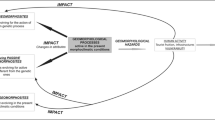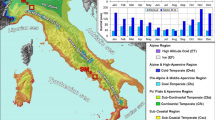Abstract
The effects of anthropogenic activities on soil evolution due to siltation and the impact on hydraulic properties of the vadose zone on the augmentation of the aquifer recharge are investigated for the Al-Khoud dam in Oman. Inside the dam reservoir and in areas adjacent to the embankment, downstream, 33 pedons (of depths between 1.5 and 2 m) were excavated and studied during 2011 and 2012. Soil analysis revealed that the subsoil’s physiochemical properties of the study area are continuously changing due to damming, i.e., alteration of the natural runoff, intensified sedimentation, and infiltration. Variation of hydropedological properties caused by the geotechnical construction is evident in a distinct vertical stratification of texture of accrued sediments and almost an order of magnitude drop in saturated hydraulic conductivity (K s ) of the dam bed. Correspondingly, spilling of ponded water over the dam crest occurs more frequent and therefore increases the potential hazards of flooding of the downstream recharge area. Some fine particles of the suspended load carried to the reservoir by the feeding wadi migrate vertically downward, driven by seepage, into the originally coarse matrix of the parent soil and cause clogging of large pores (with time, hard pans in the subsurface are developing) even without visible cake formation on the soil surface. Development of hard pans was also discovered in pedons at depths close to 1 m. This is attributed to presence of a pedogenic carbonate derived from the parent rock and formed by precipitation of dissolved salts due to a vertical upward moisture evaporation to a hot and dry bed surface during prevailing dry bed periods of dam operation. K s measured downstream of the dam was relatively high (6 m/day) and was three times higher than the average value inside the reservoir (2.1 m/day), ranging there between 0.01 and 3.96 m/day, but less than at the upstream site outside the reservoir.











Similar content being viewed by others
References
Abdalla O, Al-Abri R (2011) Groundwater recharge in arid areas induced by tropical cyclones: lessons learned from Gonu 2007 in Sultanate of Oman. Environ Earth Sci 63:229–239. doi:10.1007/s12665-010-0688-y
Abdulrazzak M (1997) Water supply augmentation through artificial groundwater recharge techniques. Proc Third Gulf Water Conf Muscat 1:241–281
Alessandro P (1998) Sustainability of dams, reservoir sedimentation management and safety implications, WW98 Dams Sustainability Report. RDV, Annapolis, MD, USA
Al-Ghafri A (1991) The geology and hydrogeology of the Al-Khoud aquifers at the western waterfield area, west of Muscat, Sultanate of Oman. PhD dissertation, University of South Carolina, USA
Al-Ismaily S, Al-Maktoumi A, Kacimov A, Al-Saqri S, Al-Busaidi H, Al-Haddabi M (2013) A morphed block-cracked preferential sedimentation: a smart design and evolution in nature. Hydrol Sci J 58(8):1–10
Al-Ismaily S, Al-Maktoumi A, Kacimov A, Al-Saqri S, Al-Busaidi H (2015) The impact of a recharge dam on the hydropedology of arid zone soils in Oman: anthropogenic formation factor. J Hydrol Eng 20(4):04014053
Al-Muttair F, Sendil U, Al-Turbak A (1994) Management of recharge dams in Saudi Arabia. J Water Resour Plan Manag 120(6):749–763
Alonso-Zarza A, Silva P, Goy J (1998) Fan-surface dynamics and biogenic calcrete development: interactions during ultimate phases of fan evolution in the semiarid SE Spain (Murcia). Geomorphology 24:147–167
Al-Rawas A, Guba I, McGown A (1998) Geological and engineering characteristics of expansive soils and rocks in northern Oman. Eng Geol 50(3–4):267–281
Al-Saqri S (2014) Hydropedology and soil evolution in explaining the hydrological aspects of recharge dams in arid zone environments, M.Sc. Thesis. Sultan Qaboos University, Oman
Al-Saqri S, Al-Maktoumi A, Al-Ismaily S, Kacimov A, Al-Busaidi A (2013) Hydropedological aspects of Al-Khoud recharge dam for future water resources management in Oman, International Conference on Agricultural Engineering. Sultan Qaboos University, Oman, 24-26/Feb
Bell J, Cameron F (1906) The flow of liquids through capillary spaces. J Phys Chem 10(8):658–674
Bella D, Overton W (1971) Environmental planning and ecological possibilities. ASCE, St. Louis, pp 18–22
Biswas A (1996) Water resources, environmental planning, management and development. Int J Water Resour Dev 4(15):429–441
Brewer R (1976) Fabric and mineral analysis of soils. Robert E. Krieger, Huntington, NY
Bryant R, Moran M, Thoma D, Holifield C, Skirvin S, Rahman M (2006) Measuring surface roughness to parameterize radar backscatter models for retrieval of surface soil moisture. Geosci Remote Sens Lett 4(1)
Chanson H, James D (1998) Siltation of Australian reservoirs: some observations and dam safety implications. The University of Queensland, Brisbane, Australia, Scientific report
Consultants S (1981) Feasibility report of Wadi Al-Khoud aquifer recharge project, Omani-American Joint Commission for Economic and Technical Cooperation. MAF, Oman
Dalal-Clayton B, Sadler B (1999) Strategic environmental assessment: a rapidly evolving approach. Environmental Planning Issues No. 18, London
De Zwart A (2007) Investigation of clogging processes in unconsolidated aquifers near water supply wells, PhD dissertation. Delft University of Technology, The Netherlands
Devi R, Tesfahune E, Legesse W, Deboch B, Beyene A (2007) Assessment of siltation and nutrient enrichment of Gilgel Gibe dam, Southwest Ethiopia. School of Environmental Health, Ethiopia
Faber S (2013) Migration and deposition of fine particles in a porous filter and alluvial deposit: 1. Experiments, M.Sc. Thesis. University of Amsterdam, The Netherlands
FitzPatrick E (1993) Soil microscopy and micromorphology. John Wiley, New York
Gee G, Bauder J (1986) Particle-size analysis. In: Klute A (ed) Methods of soil analysis, 2nd edn. ASA and SSSA, Madison, Wis, pp 383–411, Part I
George C (2000) Comparative review of environmental assessment procedures and practice. John Wiley and sons Ltd. Chichester, England
Haimerl G (2002) Groundwater recharge in wadi channels downstream of dams efficiency and management strategies, Institute of Hydraulic and Water Resources Engineering. Technische Universitat Munchen, Germany, www.tum-vao.de
Hari S, Krishna R (2004) Geoenvironmental engineering. John Wiley and Sons, Hoboken, New Jersey
Joseph O (1953) Siltation of reservoirs. Eildon surveys analysed. AQUA, Nov., University of Queensland, Australia, pp. 19–23
Kacimov A, Al-Ismaily S, Al-Maktoumi A (2010) Green-Ampt one dimensional infiltration from ponded surface into a heterogenous soil. J Irrig Drain Engg 136(1):68–72
Khakural B, Lemme G, Mokma D (1993) Till thickness and argillic horizon development in some Michigan hapludalfs. Soil Surv Horizone 34:6–13
Lin H (2003) Hydropedology: bridging disciplines, scales and data. Vadose Zone J 2:1–11
Ministry of Agriculture and Fisheries (MAF) (1990) General soil map of Oman. Ministry of Agriculture and Fisheries. Sultanate of Oman, Muscat
Ministry of Regional Municipalities and Water Resources (MRMWR) (2008) Water resources in Sultanate of Oman. Ministry of Regional Municipality and Water Resources. Sultanate of Oman, Muscat
Ministry of Regional Municipalities and Water Resources (MRMWR) (2010) Dams in Sultanate of Oman, 2nd edn, Ministry of Regional Municipality and Water Resources. Sultanate of Oman, Muscat
Mohamed M (2004) Treatment techniques of oil-contaminated soil and water aquifers, International Conference on Water Resources and Arid Environment. King Saud University, Riyadh. KSA
Montaser A, Golightly D (1992) Inductively coupled plasmas in analytical atomic spectrometry. VCH, New York
Pahl-Wost C (2006) The implications of complexity for integrated resource management. Environ Model Softw 22:561–569
Peavy H, Donald R, George T (1985) Environmental engineering, International edition. McGraw-Hill book Co, USA
Polubarinova-Kochina, P. Ya. (1977) Theory of ground-water movement, First edn. Nauka, Moscow, 1952 (in Russian), translated from the Russian by J. M. Roger de Weist (1962), Princeton: Princeton Univ. Press; second Russian edition
Prathapar S, Bawain A (2014) Impact of sedimentation on groundwater recharge at Sahalanowt dam, Salalah, Oman. Water Int 39(3):381–393. doi:10.1080/02508060.2014.895889
Reid I, Frostick L (1994) Fluvial sediment transport and deposition. Sediment transport and depositional processes. Blackwell Scientific Publications, Oxford, p 89–155
Reynolds W, Elrick D (1991) Determination of hydraulic conductivity using a tension infiltrometer. Soil Sci Soc Am J 55:633–639
Schaetzl R, Anderson S (2005) Soils: genesis and geomorphology. Cambridge University Press, Cambridge, UK
Schoelkopf J, Ridgway C, Gane P, Matthews G, Spielmann D (2000) Measurement and network modeling of liquid permeation into compacted mineral blocks, Environmental and Fluid Modeling Group. University of Plymouth PL4 8AA, United Kingdom
Shahin, M. 2007. Water resources and hydrometeorology of the Arab region. Water Science and Technology Library, Springer, 59:333–335
Sichingabula H (1997) Problems of sedimentation in small dams in Zambia: Rabat Symposium proceedings. Human Impacts on Sedimentation and Erosion [IAHS Pub.] No. 245, Rabat, Morocco
Siriwardene N, Deletic A, Fletcher T (2007) Clogging of stormwater gravel infiltration systems and filters: insights from a laboratory study. Water Res 41(7):1433–1440. doi:10.106./j.watres.2006.12.040
Stange M, Dreyer M, Rath H (2003) Capillary driven flow in circular cylindrical tubes. Journal of Physics of Fluids, Center of Applied Space Technology and Microgravity-ZARM. University of Bremen, Germany
Tan K (1996) Principles of soil chemistry, second edition. Marcel Dekker, New York NY. The Field Book for Describing and Sampling. USDA-Natural Resources Conservation Services. Washington DC
Treadwell-Steitz C, McFadden L (1999) Influence of parent materials and grain size on carbonate coating in gravelly soils, Palo Duro Wash, New Mexico. Geoderma 94:1–22
Wanyonyi S (2002) Sediment management in Masinga Reservior, Kenya, PhD dissertation. Institute of Water Management. University of Agricultural Sciences (BOKU), Vienna, Austria
Watson J, Hardy L, Cordell T, Cordell S, Minch E, Pachek C (1995) How water moves through soil, College of Agriculture. The University of Arizona, Tucson, USA
Wooding R (1968) Steady infiltration from large shallow circular pond. Water Resour Res 4:1259–1273
Acknowledgments
The authors would like to thank Sultan Qaboos University for the support. This work is part of DOPSAR project” Effects of siltation behind Al-Khoud dam on the soil properties and recharge efficiency” IG/AGR/SWAE/10/02.
Author information
Authors and Affiliations
Corresponding author
Rights and permissions
About this article
Cite this article
Al-Saqri, S., Al-Maktoumi, A., Al-Ismaily, S. et al. Hydropedology and soil evolution in explaining the hydrological properties of recharge dams in arid zone environments. Arab J Geosci 9, 47 (2016). https://doi.org/10.1007/s12517-015-2076-0
Received:
Accepted:
Published:
DOI: https://doi.org/10.1007/s12517-015-2076-0




